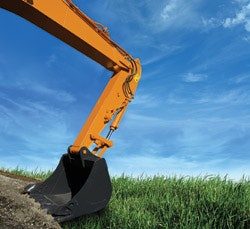
So what's a pool builder to do? Pool industry manufacturers have developed revolutionary products such as variable-speed pumps, low-NOx heaters, automated controls and solar heating systems that are at the forefront of environmental stewardship, but there isn't a standardized metric that a pool builder can use to quantitatively evaluate a project's sustainability.
Such tools do exist for buildings. Standards such as the U.S. Green Building Council's LEED (Leadership in Energy and Environmental Design) rating system are increasingly well known and sought after. LEED provides guidance on reducing the environmental impact of construction. The system provides incentive with a point system and certifications. While LEED addresses some site issues, it does not fully address landscape sustainability, and it doesn't mention pool construction at all.
Some individuals have forged ahead, educating themselves on green practices, but most organizations are scrambling to catch up. For example, the International Association of Plumbing and Mechanical Officials, a standards organization, just announced its intention to "develop and maintain a supplemental document establishing requirements for green plumbing and mechanical systems." IAPMO's Green Technical Committee will also seek ways to incorporate sustainable practices into existing uniform codes.
The American Society of Landscape Architects undertook the Sustainable Sites Initiative in 2005 and is working to develop standards and guidelines for reducing the environmental impact of landscapes. "These standards and guidelines will include criteria for site design, implementation and maintenance. The initiative will analyze, consolidate and advance the research needed to establish sound metrics and create regional guidelines and incentives for sustainable sites," the Sustainable Sites Initiative's mission statement says.
Until some organization develops rating systems and sustainable-practices standards that address the unique characteristics of pools, builders can look to authorities like the USGBC and ASLA for principals that will help green the pool construction process.
Best Ideas Are Borrowed
How does LEED lead? According to the organization's mission statement, by promoting a "whole-building approach to sustainability, recognizing performance in five key areas of human and environmental health: sustainable site development, water savings, energy efficiency, materials selection and indoor environmental quality." Each of those areas potentially impact pool building, so LEED may be a good place to start. Following are some ideas that pool builders can easily incorporate.
Think First
"Before you dig that hole, before you even start that excavation, figure out where the best place is to physically site the pool," says Rebecca Flood, a LEED-Accredited Professional with Ken Saiki Design in Madison, Wis. "That's a basic principle of sustainability: trying to work with an existing site or existing conditions as much as possible. Building on a previously developed site is better than building on untouched land. So if there's an area that's already been disturbed because of a previous building foundation or something of that nature, you can rework that existing footprint, so you don't disturb untouched land.
"If you site such that you preserve the existing natural features - what we call natural amenities - that would be practicing good sustainable design. If you save a mature stand of trees on the site, for example, that could provide shade for the pool deck. You would avoid something like steep slopes because of the erosion potential. You would try to protect mature, existing stands of vegetation. You would site to take advantage of passive solar in the North, or to provide shade in warm climates," says Flood.
Once You're There
The LEED system breaks projects into several areas where the building can earn points. One of the prerequisites in the sustainable-site category is construction-activity-pollution prevention. LEED requires compliance with minimum EPA standards that apply to construction activity, or local standards when they are more stringent. "If you're removing an existing foundation, is there any way you can recycle that, rather than hauling it away to a landfill?" says Flood. "Are you taking measures at the onset of construction so that you're not creating erosion hazards, you're not silting local waterways, you're not allowing topsoil - which is really a resource - to wash off site?" asks Flood.
Recycled Content
Pool projects can really shine when it comes to points for recycled content. Fly ash is a byproduct of burning coal, and aggregate may be recycled material. Rebar often contains a high proportion of recycled material. "Or if you're tiling the pool, can you use recycled glass tile?" asks Flood.
Regional Materials
"There is also LEED guidance about regional materials," says Flood. "So if you were mixing concrete from local aggregate that was batched at a plant near the building site and then trucked to the site - and concrete is the primary ingredient for a pool - you may be able to achieve that regional-materials-use credit." These credits reward use of materials that were sourced or manufactured within a 500-mile radius of the construction site.
Sustainability almost always favors local over imported. "If builders can sway their clients to forego the marble from China and try to keep it to a local quarry, that's much more sustainable," says Thomas R. Tavella, vice president of BSC Group in Glastonbury, Conn., and vice president of communications for ASLA.
"If you think about sustainability in the even bigger sense, utilizing local labor forces and local materials, and basically keeping the business cycle within your local economy, does a huge amount toward the sustainability of your local community," says Flood.
Think of it like buying food at a grocery store where the out-of-season apples may have traveled from New Zealand, compared to going to the farmer's market where the food is grown two miles outside of the city. "That's more than just environmental sustainability. It's economic sustainability and probably some small amount of social sustainability," she says. All that from concrete!
Cleaning Up After Yourself
After construction and basic site cleanup (separating and recycling or properly disposing of waste materials), sustainability requires that the land be restored to health. A major issue is the compaction of the land that normally occurs during construction. Compaction degrades soil structure and reduces infiltration rates, which in turn increases the runoff volume and flooding potential. Compacted soils don't have spaces for oxygen and water, making it difficult to plant or restore vegetation. Compressed soil reduces root growth and access to water and nutrients.
"One of the things you can do up front, before you even dig the hole, is set up a smaller construction boundary," says Flood. "You minimize the amount of total disturbance by limiting yourself to the boundary. It also helps at the end when you are trying to restore things, because inevitably the soil will be compacted just because of the equipment and the construction process. If you have less area that you have to restore in the end, you may save yourself money in the long haul." Restoration may include aerating the compacted soil, excavating debris and even bringing in topsoil or amendments.
Stay Cool
They may not know it, but pool builders are already incorporating one LEED goal into pool decks. "Another LEED priority is preventing the heat-island effect," says Tavella. "We try to reduce that by making sure there's tree cover for shade or that any hardscapes have high-reflectivity so they aren't absorbing the heat." So when builders choose light colors for deck surfaces in order to protect bare feet from burning, they are also earning LEED points.
Thoughtful project management goes a long way toward earning LEED points. Many sustainable practices are also just elements of good, efficient construction management. Considered the other way, builders who adopt LEED concepts may find that their businesses become more efficient and that profits inch up. Do you plan ahead so as to reduce waste? Do you keep the site organized so that reusable materials actually are reusable? Do you keep debris separated for easy recycling? Do you schedule material deliveries so that they don't sit on the site for long periods of time? If so, you're already working sustainably.
Resources
www.sustainablesites.orgThe Sustainable Sites Initiative is an interdisciplinary partnership between the American Society of Landscape Architects, the Lady Bird Johnson Wildflower Center, the United States Botanic Garden and a diverse group of stakeholder organizations to develop guidelines and standards for landscape sustainability. The motivation behind this initiative stems from the desire to protect and enhance the ability of landscapes to provide services such as climate regulation, clean air and water, and improved quality of life. Sustainable Sites is a cooperative effort with the intention of supplementing existing green building and landscape guidelines as well as becoming a stand-alone tool for site sustainability.
www.usgbc.org
The U.S. Green Building Council is a nonprofit organization that works to transform the way buildings and communities are designed, built and operated, enabling an environmentally and socially responsible, healthy, and prosperous environment that improves the quality of life. Find information on LEED here.







































